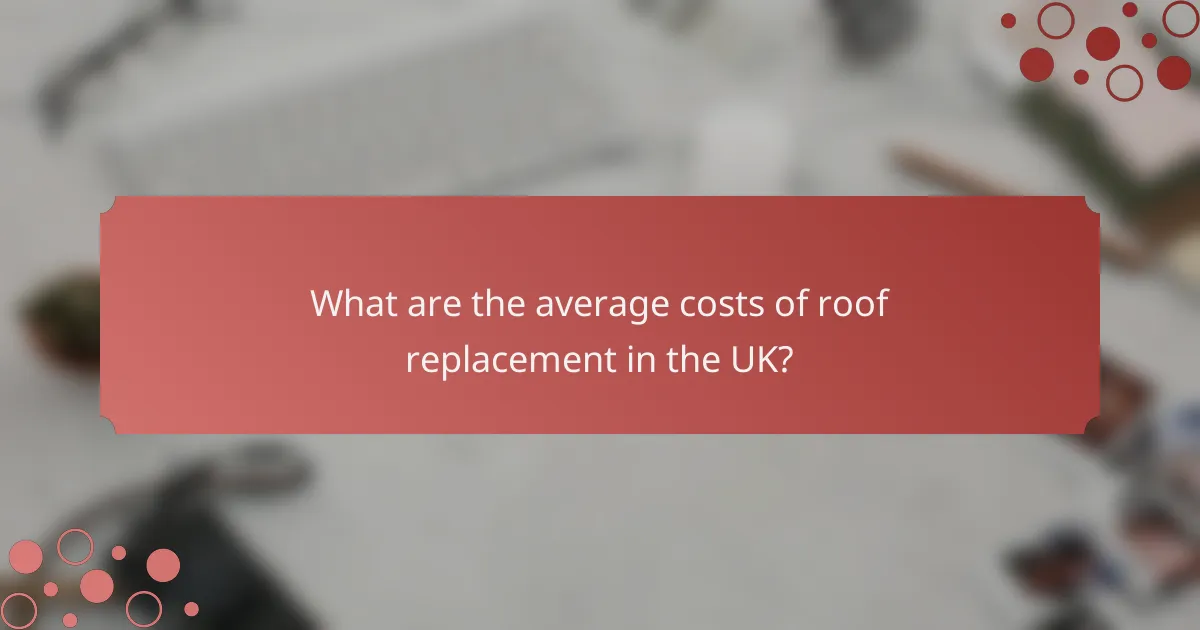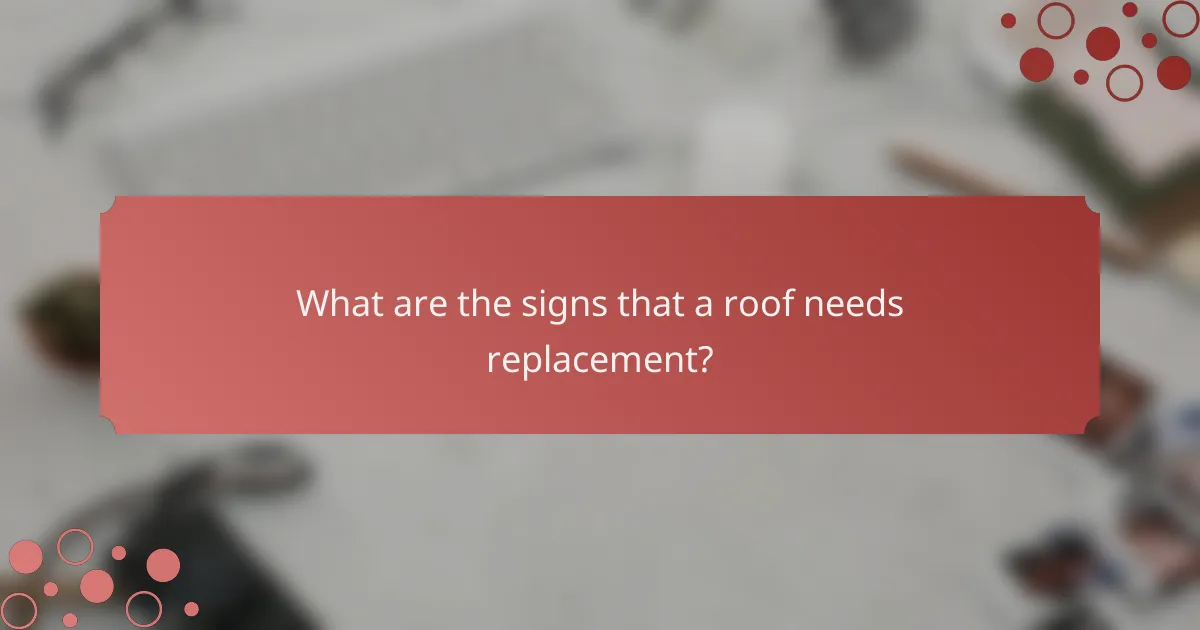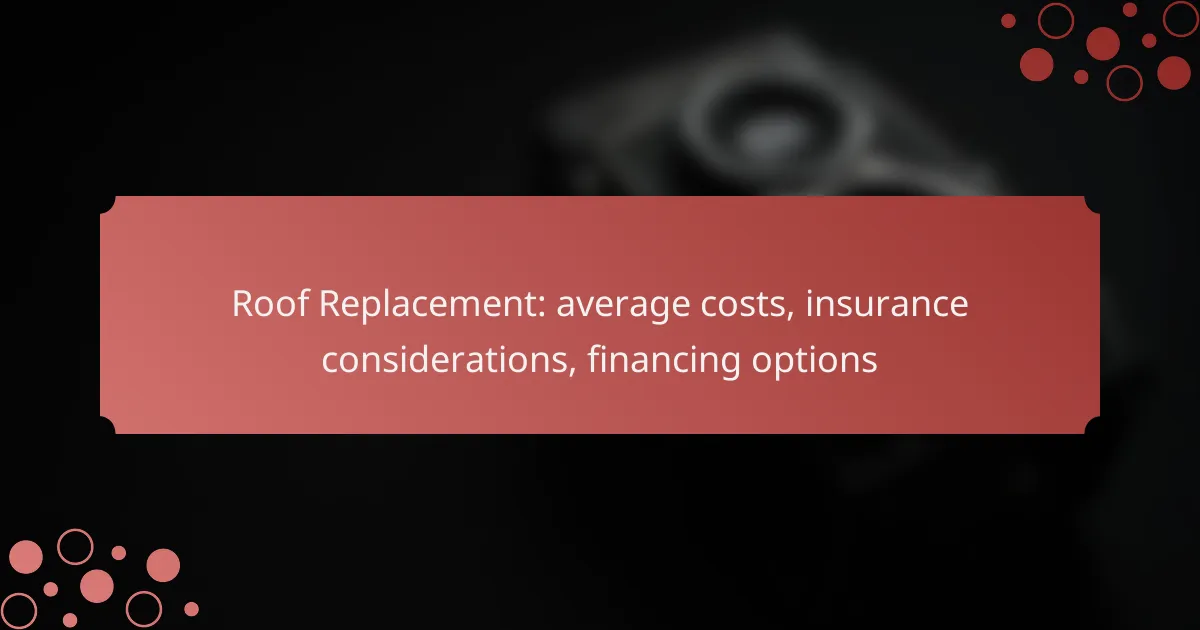Replacing a roof can be a significant investment for homeowners, with average costs in the UK ranging from several thousand to over ten thousand pounds, influenced by material choices and installation complexity. Understanding your insurance policy is essential, as it dictates coverage for damages and out-of-pocket expenses. Additionally, various financing options, such as home equity loans and government grants, can help manage these costs effectively.

What are the average costs of roof replacement in the UK?
The average costs for roof replacement in the UK can vary significantly based on the type of materials used and the complexity of the installation. Generally, homeowners can expect to pay anywhere from several thousand to over ten thousand pounds, depending on their specific needs and choices.
Cost range for asphalt shingles
Asphalt shingles are one of the most common roofing materials in the UK due to their affordability and ease of installation. The cost for replacing a roof with asphalt shingles typically ranges from £3,000 to £5,500, depending on the size of the roof and the quality of the shingles chosen.
When considering asphalt shingles, it’s important to factor in the lifespan of the material, which usually lasts around 15 to 30 years. This can influence long-term costs and maintenance considerations.
Cost range for slate roofs
Slate roofs are known for their durability and aesthetic appeal, but they come at a higher price point. The cost for replacing a roof with slate can range from £7,000 to £15,000 or more, depending on the size and type of slate used.
Investing in a slate roof can be worthwhile due to its longevity, often exceeding 50 years, and low maintenance requirements. However, the initial investment is significantly higher than other materials.
Cost range for tile roofs
Tile roofs, particularly clay or concrete tiles, offer a robust and attractive option for homeowners. The cost for tile roof replacement generally falls between £5,000 and £10,000, influenced by the roof’s size and the specific type of tiles selected.
Tile roofs are known for their durability and can last 30 to 50 years, making them a solid investment. However, they can be heavier than other materials, which may require additional structural support.
Factors affecting roof replacement costs
Several factors can influence the overall cost of roof replacement, including the type of roofing material, the size of the roof, and the complexity of the installation. Additional costs may arise from necessary repairs to the underlying structure or the removal of the old roof.
Other considerations include labor costs, which can vary by region and the experience of the roofing contractor. It’s advisable to obtain multiple quotes to ensure competitive pricing.
Regional cost variations in England
Roof replacement costs can vary significantly across different regions of England. Generally, urban areas like London may see higher costs due to increased labor rates and demand, while rural areas may offer more competitive pricing.
For example, homeowners in the South East might pay 10-20% more compared to those in the North East for similar roofing projects. It’s essential to consider local market conditions when budgeting for a roof replacement.

How does insurance affect roof replacement?
Insurance plays a crucial role in roof replacement by determining what damages are covered and how much you will need to pay out-of-pocket. Homeowners should understand their policy details to effectively navigate claims and minimize costs associated with roof repairs or replacements.
Types of coverage for roof damage
Most homeowners’ insurance policies include coverage for roof damage caused by specific perils, such as fire, hail, and windstorms. There are generally two types of coverage: actual cash value (ACV) and replacement cost value (RCV). ACV pays for the current value of the roof, factoring in depreciation, while RCV covers the full cost of replacing the roof without depreciation deductions.
It’s important to review your policy to confirm which type of coverage you have, as this will significantly impact your financial responsibility during a roof replacement.
Common exclusions in roof insurance
Many insurance policies contain exclusions that can affect roof replacement claims. Common exclusions include damage from lack of maintenance, wear and tear, and certain natural disasters like earthquakes or floods, unless additional coverage is purchased. Understanding these exclusions can help homeowners avoid surprises when filing a claim.
Additionally, some policies may not cover cosmetic damage, so it’s essential to clarify what is included in your coverage to ensure adequate protection.
How to file a roof replacement claim
Filing a roof replacement claim typically involves several key steps. First, document the damage with photos and notes, then contact your insurance company to report the claim. Be prepared to provide details about the incident and any relevant policy information.
After filing, an adjuster will likely inspect the damage to assess the claim. It’s advisable to have a contractor present during this inspection to ensure all necessary repairs are accounted for. Keep records of all communications and documents related to the claim for future reference.

What financing options are available for roof replacement?
Several financing options exist for roof replacement, including home equity loans, personal loans, and government grants. Each option has unique benefits and considerations that can help homeowners manage the costs effectively.
Home equity loans for roof replacement
Home equity loans allow homeowners to borrow against the equity they have built in their property. Typically, these loans offer lower interest rates compared to personal loans, making them an attractive choice for financing roof replacements.
To qualify, homeowners usually need a good credit score and sufficient equity, often at least 15-20% of the home’s value. It’s important to consider that this type of loan is secured by the home, meaning failure to repay could lead to foreclosure.
Personal loans for roofing projects
Personal loans are unsecured loans that can be used for various purposes, including roof replacement. These loans generally have higher interest rates than home equity loans but can be easier to obtain, especially for those without significant home equity.
When considering a personal loan, it’s crucial to compare interest rates and terms from multiple lenders. Borrowers should also be aware of any fees associated with the loan, as these can affect the overall cost of financing the roofing project.
Government grants for roof repairs
Government grants for roof repairs are available in some regions, aimed at assisting low-income homeowners or those in specific circumstances, such as natural disaster recovery. These grants do not require repayment, making them an excellent option for eligible individuals.
To find available grants, homeowners should check with local government agencies or non-profit organizations. Eligibility criteria can vary, so it’s essential to review the requirements carefully and apply promptly, as funding may be limited.

What factors should be considered before replacing a roof?
Before replacing a roof, it’s essential to evaluate factors such as the type of roofing material, the local climate, and the choice of a qualified contractor. These elements significantly influence the durability, cost, and overall success of the roofing project.
Roofing material durability
The durability of roofing materials varies widely, affecting both the lifespan and maintenance needs of your roof. Common materials include asphalt shingles, which last around 15-30 years, and metal roofs, which can endure for 40-70 years with proper care.
When selecting materials, consider their resistance to weather conditions and potential damage. For instance, slate and tile roofs are highly durable but come with a higher upfront cost. Weighing the long-term benefits against initial expenses is crucial for making an informed choice.
Climate considerations in the UK
The UK’s climate, characterized by frequent rain and varying temperatures, necessitates specific roofing considerations. Materials that can withstand moisture and temperature fluctuations are vital to prevent leaks and structural damage.
For example, slate and tiles are popular in the UK due to their water resistance and longevity. Additionally, ensure proper insulation and ventilation to mitigate issues related to condensation, which can lead to mold and decay over time.
Choosing a reputable roofing contractor
Selecting a qualified roofing contractor is critical for ensuring a successful roof replacement. Look for professionals with good reviews, proper licensing, and insurance coverage to protect against potential liabilities.
Request multiple quotes and check references to gauge their reliability and workmanship. A reputable contractor will provide a detailed estimate, including material costs and labor, helping you avoid unexpected expenses during the project.

What are the signs that a roof needs replacement?
Several indicators can signal that a roof requires replacement, including visible leaks, damaged shingles, and the age of the roof. Recognizing these signs early can help prevent more extensive damage and costly repairs.
Visible leaks and water damage
Visible leaks and water damage are clear signs that a roof may need replacement. If you notice water stains on ceilings or walls, or if water drips during rain, it’s crucial to assess the roof’s condition. Persistent leaks can lead to mold growth and structural damage, making timely replacement essential.
Inspect your attic for signs of moisture or water stains, especially after heavy rain. If leaks are frequent, it’s often more cost-effective to replace the roof rather than continually patching it.
Missing or damaged shingles
Missing or damaged shingles can significantly compromise a roof’s integrity. Look for shingles that are cracked, curled, or completely missing, as these can expose the underlying materials to the elements. If you find several damaged shingles, it may indicate that the roof is nearing the end of its lifespan.
Regularly inspect your roof after storms or high winds. If you notice extensive damage, consider a full replacement rather than individual repairs, which can be more expensive in the long run.
Age of the roof
The age of the roof is a critical factor in determining whether it needs replacement. Most asphalt shingle roofs last around 20 to 30 years, while metal roofs can last 40 years or more. If your roof is approaching or exceeding its expected lifespan, it’s wise to consider replacement.
Check the installation date of your roof and keep track of any repairs made over the years. If your roof is older and showing other signs of wear, it may be time to invest in a new roof to ensure your home remains protected.
